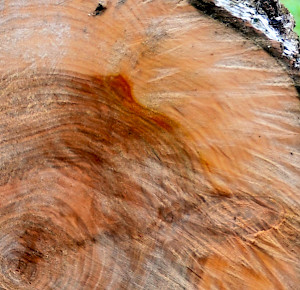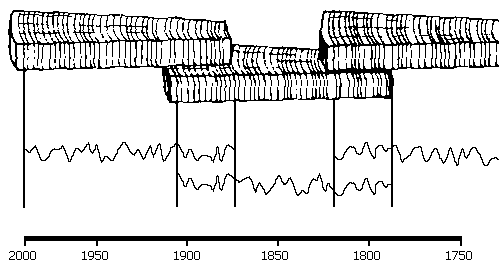Dendrochronology
Dendrochronology: dating a wooden object on the basis of the growth rings of a tree. This is one of the most accurate ways to date an ancient object.

Dendrochronology ("tree chronology") is essentially a simple method, and as children we all have done dendrochronological research. When a tree is felled, it is possible to count the growth rings, and because we know that a tree makes a new ring every year, we can establish in which year the tree was planted.
But although a tree makes a new ring every year, not every annual ring is the same. In wet and warm years, trees grow well, in cold and dry years hardly at all. A thin annual ring therefore is an indication for a cold year and a thick ring is proof that the year was warm. Since the summers and winters of consecutive years are never completely the same, the rings of trees show an irregular pattern: thick and thin rings alternate with each other without any particular system.
This irregular pattern is expressed in a dendrochronological curve: along the vertical axis, we can plot the thickness of the ring, and along the horizontal axis, we can plot the years. Now it becomes possible to count backwards over very, very long periods.

In the picture above, we see three pieces of wood. The first tree was cut down in 2000, and it is possible to count backwards to 1870. The second piece of wood is taken from a supporting beam in a house built at the beginning of the twentieth century. There is an overlap for the years 1870-1910: both trees have the same pattern of thick and thin annual rings. More or less the same can be said for the third part of our series, found in a windmill built in 1820.
The trick is to find ancient wood, and to fit it to an already existing series of rings. For several regions (e.g., California and northwestern Europe) it has already been possible to make a chronology reaching back thousands of years. Using series like these, an archaeologist who finds a piece of wood can date it simply by comparing and matching it ring for ring to the known curve.
The accuracy depends on three factors. In the first place, the piece of wood that must be dated has to have at least forty rings. Secondly, its rings can only be compared to a dendrochronological curve from the same climatic region. Finally, if the border between the sapwood and the heartwood is still present, the moment of the cutting of the tree can be dated exactly; otherwise, we find a terminus post quem (which can also be very important). Wood of the oak and the ash are better than others.
For the Aegean world, at the moment we do have a series of rings reaching back to 363 CE. There is another series (with a length of 1503 years) that does not fit to this series: there is a gap of several centuries. However, by using radiocarbon dating, American dendrochronologists have been able to date this series to 2220-718 BCE.
This method was first developed by the American scientist A.E. Douglass at the beginning of the twentieth century. He used it to establish the antiquity of pre-Columbian villages in Arizona and New Mexico.